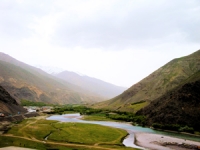Water sharing between Central Asian countries has been conflicting for quite a long time already.
Pros and Cons of Adopting Water-Wise Approaches in the Lower Reaches of the Amu Darya: A Socio-Economic View
The increased frequency of water shortages parallel to growing demands for agricultural commodities in the lower reaches of the Amu Darya River, Central Asia, calls for improving the system-level water use efficiency, by using interventions at the field level. Despite the existence of various best practices of effective water use (defined here as “water-wise options”), they are not widely adopted by farmers owing to high initial costs of investment and lack of the necessary knowledge and skills of a new generation of farmers after the Soviet era. For assessing the potential of several water-wise techniques, key indicators such as water use reduction rate (WURR), economic efficiency (EE), and financial viability (FV) were combined with expert surveys. A SWOT procedure was used to analyze the (dis)advantages, opportunities and constraints of adopting the selected water-wise methods. Results show that the examined options have substantial potential for increasing water use efficiency under promising EE. The various recommendations aim at improving the sustainability of irrigation water use.





